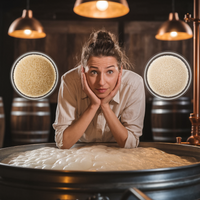What Is the Difference Between Ale and Lager Yeast?
Posted by Matteo Lahm on 26th Mar 2025
When it comes to brewing beer, yeast plays a crucial role in determining your beer's flavor, aroma, and overall character. All beers fall into two umbrella categories: ales and lagers, and the type of yeast used to ferment them is the difference. But how are ale and lager yeasts different? Understanding how these yeast strains behave, their fermentation characteristics, and the flavors they contribute is key to mastering the art of brewing.
Ale and lager yeasts are indeed different species, though they share similarities. Ale yeast is typically classified as Saccharomyces cerevisiae, while lager yeast belongs to the Saccharomyces pastorianus species. The latter is a hybrid strain, likely originating from a combination of ale yeast and Saccharomyces eubayanus, a wild yeast found in colder environments. This genetic difference results in distinct fermentation behaviors, environmental requirements and flavor contributions.
Fermentation Conditions: Warm vs. Cold
One of the biggest differences between ale and lager yeast is their preferred fermentation temperature. Ale yeasts are known as "top-fermenting" because they tend to rise to the surface during fermentation. They work best at warmer temperatures, typically between 60–75°F (15–24°C). This warmer fermentation produces a faster turnaround time, which is why ales generally take less time to brew than lagers.
Lager yeasts, on the other hand, are "bottom-fermenting" and thrive at much cooler temperatures, typically 45–55°F (7–13°C). These lower temperatures slow down the fermentation process, often requiring weeks or even months to fully develop. The longer maturation period results in a cleaner, crisper beer with fewer fermentation-derived flavors.
Techniques for Achieving Lager Fermentation Temperatures
Because lagers require colder fermentation conditions, homebrewers must find ways to maintain steady, cool temperatures throughout the process. Here are some effective techniques:
Temperature-Controlled Fermentation Chambers: A refrigerator or chest freezer with an external temperature controller allows precise regulation of fermentation temperatures.
Using Ice Baths or Swamp Coolers: Placing the fermenter in a large container of water and rotating frozen bottles of water can help maintain cooler temperatures.
Utilizing a Cool Basement or Cellar: If you have a basement that stays within the lager fermentation range, it can be an ideal natural cooling option.
Seasonal Brewing: Many homebrewers take advantage of colder seasons to brew lagers. Outdoor spaces like porches, garages, or sheds can provide the necessary cool environment during winter months, making lager brewing more accessible without specialized equipment.
Flavor Differences: Fruity vs. Clean
The temperature at which yeast ferments has a direct impact on the flavors it produces. Ale yeasts tend to create more esters and phenols, which contribute fruity and spicy notes to the beer. Common flavors produced by ale yeast include:
Banana
Clove
Apple
Pear
Bubblegum
These esters are particularly noticeable in styles like Belgian ales, hefeweizens, and English bitters.
Lager yeasts, in contrast, produce far fewer esters and phenols due to their cooler fermentation temperatures. This results in a cleaner, crisper taste with more emphasis on the malt and hops. Some subtle flavors from lager yeast can include:
Light sulfur notes (which typically fade with conditioning)
A slight touch of sweetness
A smooth, refined finish
Lagers like pilsners, helles, and dunkels highlight these characteristics beautifully.
Alcohol Levels: Ales vs. Lagers
Another key difference between ale and lager yeast is how they affect the beer's alcohol content. Ale yeasts generally ferment more aggressively and can tolerate higher alcohol levels, making them ideal for brewing strong beers such as IPAs, stouts, and Belgian tripels. Lager yeasts, while still capable of producing high-alcohol beers, typically ferment more slowly and result in beers with a more moderate alcohol content. This is why many traditional lagers, such as pilsners and helles, have a lower ABV compared to stronger ale styles. However, specialized lager strains, such as those used for doppelbocks or Baltic porters, can produce higher-alcohol beers while maintaining their signature clean and smooth fermentation profile.
Nutrient Requirements
While yeast nutrients benefit both yeast types, lagers typically require more during fermentation due to the colder temperatures at which they ferment. The cooler environment slows down yeast metabolism, making it harder for the yeast to fully utilize available sugars and essential nutrients especially as alcohol levels increase. To ensure a healthy fermentation, brewers often add yeast nutrients containing zinc, nitrogen, and other essential minerals. Additionally, lager fermentations require a higher initial yeast pitch rate compared to ales, sometimes up to twice as much, to compensate for the slow fermentation process. Proper nutrient supplementation helps avoid sluggish fermentations and off-flavors, ensuring a clean and well-attenuated lager.
Choosing the Right Yeast for Your Beer
If you're brewing a beer and wondering whether to use ale or lager yeast, consider the style you're aiming for. If you want a beer with bold yeast-driven flavors and a shorter fermentation time, ale yeast is the way to go. If you prefer a clean, smooth, and crisp beer with a longer maturation process, lager yeast is your best bet.
Both yeasts have their place in brewing, and understanding their differences helps you craft the perfect beer. Whether you're a homebrewer or just a beer enthusiast, knowing how ale and lager yeasts work will give you a deeper appreciation for the world of beer and assist you in identifying the subtleties that distinguish them.

